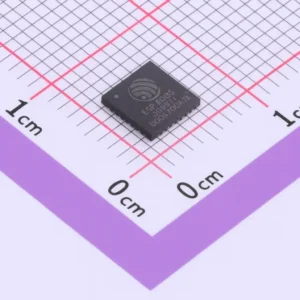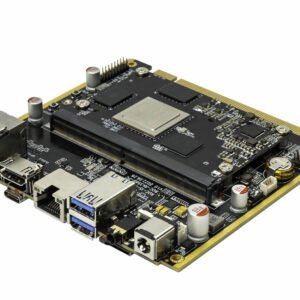RK3566 Rockchip RK3566 Processor – Quad-Core Cortex-A55 SoC with 4K Video and NPU
-
Quad-core Cortex-A55 up to 2.0 GHz for responsive, power-efficient embedded compute.
-
1 TOPS NPU + Mali-G52 GPU for edge AI and modern graphics/compute APIs.
-
4Kp60 decode, 1080p60 encode, and multi-display support for rich media scenarios.
Rockchip RK3566 Overview: Balanced Performance for Edge AI, Multimedia, and Embedded Systems
The Rockchip RK3566 is a highly integrated quad-core application processor that brings together energy-efficient CPU performance, a capable 3D/2D graphics pipeline, built-in neural processing, and robust multimedia and display engines. At its core are four Arm® Cortex-A55 CPUs clocked up to 2.0 GHz, providing a responsive general-purpose compute platform for gateways, HMI panels, media devices, and AIoT endpoints where low power and sustained throughput matter.
For graphics and UI-rich applications, the SoC integrates an Arm Mali-G52 2EE GPU that supports modern graphics and compute APIs (OpenGL ES 1.1/2.0/3.2, OpenCL 2.0, Vulkan 1.1). This combination enables fluid user interfaces, 2D/3D visualizations, and GPU-accelerated effects within embedded form factors. A dedicated 2D engine further accelerates common composition and blitting tasks to keep UIs snappy while reducing CPU overhead.
A key differentiator for the RK3566 is its on-chip NPU delivering up to 1 TOPS of AI inference. With mixed-precision support (INT8/INT16/FP16/BFP16 MACs) and toolchain compatibility for popular deep-learning frameworks like TensorFlow, PyTorch, MXNet, and Caffe, developers can deploy object detection, classification, OCR, and speech models directly at the edge without cloud round-trips. This on-device intelligence shortens response times and enhances privacy.
On the media side, RK3566 integrates hardware codecs capable of 4Kp60 decoding (H.265/H.264/VP9) and 1080p60 encoding (H.264/H.265). This makes the platform suitable for media players, conference terminals, surveillance recorders, and signage where high-resolution playback or real-time encoding is needed. An image signal processor (ISP) up to 8-megapixels, plus multi-channel audio interfaces, help realize camera-enabled and voice-centric designs.
For displays, the SoC supports single-display output over a wide range of interfaces—eDP, HDMI 2.0, MIPI-DSI, LVDS, 24-bit RGB, and EBC—providing layout flexibility from compact handheld screens to large external panels. On the I/O side, designers get USB 2.0/3.0, PCIe (including Gen3), SATA 3.0 for storage, and Ethernet MAC connectivity (GMII/QSGMII), enabling rich peripheral attachment and networking. Memory support spans DDR3/DDR3L/DDR4/LPDDR3/LPDDR4/LPDDR4X to address diverse cost, power, and bandwidth targets.
In short, the RK3566 is a balanced SoC that delivers modern compute, graphics, AI, and multimedia capabilities with the connectivity and memory flexibility needed for robust product designs across industrial and consumer markets.
Rockchip RK3566 Specifications
| Parameter | Description |
|---|---|
| CPU | Quad-core Arm Cortex-A55, up to 2.0 GHz. |
| GPU | Arm Mali-G52 2EE; dedicated 2D processor. Supports OpenGL ES 1.1/2.0/3.2, OpenCL 2.0, Vulkan 1.1. |
| NPU | Up to 1 TOPS; supports INT8/INT16/FP16/BFP16; models convertible from TensorFlow, PyTorch, MXNet, Caffe. |
| Video decode | 4K@60 fps H.265/H.264/VP9. |
| Video encode | 1080p@60 fps H.265/H.264. |
| ISP | Up to 8-megapixel image signal processor. |
| Display interfaces | eDP, HDMI 2.0, MIPI-DSI, LVDS, 24-bit RGB, EBC; single-display support. |
| Audio | 1×8-ch I²S/TDM, 1×8-ch PDM, 2×2-ch I²S. |
| Memory | DDR3, DDR3L, DDR4, LPDDR3, LPDDR4, LPDDR4X. |
| High-speed I/O | USB 2.0, USB 3.0, PCIe 3.0 / 2.1, SATA 3.0, GMII/QSGMII. |
| Target markets | Personal mobile internet devices and AIoT equipment. |
Notes: The above values are sourced from the official product page you provided; interface availability can vary by board or design. Always confirm pin-mux and BOM choices in your hardware platform.
Applications and Solution Ideas
Smart displays and HMI panels
Use the RK3566’s GPU and 2D engine to deliver fluid UIs on eDP/MIPI-DSI/LVDS panels. The CPU cluster handles control logic, while the NPU accelerates on-device vision tasks like gesture recognition or barcode scanning. HDMI 2.0 enables external display mirroring for kiosks and information terminals.
Edge AI gateways and industrial IoT
With a 1 TOPS NPU and multi-protocol I/O (PCIe for expansion, USB for sensors, GMII/QSGMII for Ethernet), the RK3566 can ingest sensor data, run inference locally, and backhaul summarized insights to the cloud. Use DDR4/LPDDR4X for bandwidth-intensive inference pipelines; choose lower-power memory for battery-sensitive endpoints.
Media players, conference terminals, and signage
Hardware decoding of 4Kp60 streams (H.265/H.264/VP9) ensures smooth playback for OTT/IPTV set-tops, digital signage players, and presentation devices. For collaboration systems, the 1080p60 encoder supports live video uplinks, and the 8-MP ISP streamlines camera integration.
Surveillance NVRs and smart cameras
Combine the 1080p60 encoder with the ISP for compact recording devices or edge cameras that need on-device analytics (e.g., person detection) powered by the NPU. SATA 3.0 accommodates local storage, while PCIe and USB support capture cards or additional NICs.
Portable computing and embedded handhelds
The Cortex-A55 cluster balances compute and efficiency for browsers, lightweight productivity, or custom Linux/Android apps. Broad memory support lets OEMs optimize for cost or performance; the 2D/3D engines keep UI latency low even on modest thermal budgets.
Why Choose Rockchip RK3566?
Modern performance where it counts – Four Cortex-A55 cores at up to 2.0 GHz provide excellent perf-per-watt for always-on embedded systems, while the Mali-G52 GPU and 2D engine ensure smooth graphics and UI rendering.
Ready for on-device AI – A built-in NPU (≈1 TOPS) with mixed-precision MACs and compatibility with mainstream frameworks makes it straightforward to deploy edge inference without cloud latency.
Rich connectivity and display options – Multiple display buses (eDP/HDMI/MIPI/LVDS/RGB) and high-speed I/O (USB 3.0, PCIe, SATA, Ethernet MAC) give designers flexibility across form factors—from compact panels to networked gateways and media hubs.
Developer Considerations
-
Memory planning: Choose LPDDR4/LPDDR4X for maximum bandwidth in AI + multimedia workflows; DDR3(L)/DDR4 may optimize cost for simpler UI devices.
-
Thermals and enclosures: 4K decode and NPU workloads can be sustained in fanless designs with proper heat spreading. Validate worst-case codec + AI duty cycles.
-
OS and BSPs: The RK3566 ecosystem commonly targets embedded Linux or Android variants; select a board or module with an active BSP and long-term kernel support.
-
Interfaces and pin-mux: Early in design, map display, camera, audio, and storage lanes to avoid conflicts; the SoC offers many options, but boards have finite routes.
Three Quick Highlights
-
Quad-core Cortex-A55 up to 2.0 GHz for responsive, power-efficient embedded compute.
-
1 TOPS NPU + Mali-G52 GPU for edge AI and modern graphics/compute APIs.
-
4Kp60 decode, 1080p60 encode, and multi-display support for rich media scenarios.
Rockchip RK3566 Feature Summary (Detailed)
-
CPU complex: 4× Arm Cortex-A55 @ up to 2.0 GHz.
-
GPU & graphics: Mali-G52 2EE with OpenGL ES 1.1/2.0/3.2, OpenCL 2.0, Vulkan 1.1; dedicated 2D engine.
-
Neural processing: 1 TOPS NPU; mixed-precision (INT8/INT16/FP16/BFP16); model conversion from major frameworks.
-
Video: Decode 4K60 (H.265/H.264/VP9); encode 1080p60 (H.265/H.264).
-
Imaging: 8-MP ISP for camera inputs.
-
Displays: eDP, HDMI 2.0, MIPI-DSI, LVDS, 24-bit RGB, EBC (single-display).
-
Audio I/O: 1×8-ch I²S/TDM, 1×8-ch PDM, 2×2-ch I²S.
-
Memory: DDR3/DDR3L/DDR4/LPDDR3/LPDDR4/LPDDR4X.
-
Connectivity & expansion: USB 2.0, USB 3.0, PCIe 3.0/2.1, SATA 3.0, Ethernet MAC (GMII/QSGMII).
-
Target devices: Personal mobile internet devices and AIoT equipment.
H2: Rockchip RK3566 Specifications, Interfaces, and AI Features
Below is a consolidated, two-column specifications table suitable for product pages and datasheets.
| Item | Rockchip RK3566 Details |
|---|---|
| CPU | Quad-core Arm Cortex-A55 up to 2.0 GHz (power-efficient 64-bit cores). |
| GPU | Arm Mali-G52 2EE with OpenGL ES 1.1/2.0/3.2, OpenCL 2.0, Vulkan 1.1; dedicated 2D engine for UI composition. |
| NPU | Approx. 1 TOPS; mixed-precision MACs (INT8/INT16/FP16/BFP16). Models convertible from TensorFlow, PyTorch, MXNet, Caffe. |
| Video Decode | 4K@60 fps H.265/H.264/VP9 hardware decoding. |
| Video Encode | 1080p@60 fps H.264/H.265 hardware encoding. |
| ISP | Up to 8 MP camera ISP pipeline. |
| Display | Single display via eDP, HDMI 2.0, MIPI-DSI, LVDS, 24-bit RGB, EBC. |
| Audio | 1×8-ch I²S/TDM, 1×8-ch PDM, 2×2-ch I²S for flexible capture/playback paths. |
| Memory | DDR3/DDR3L/DDR4/LPDDR3/LPDDR4/LPDDR4X memory interfaces. |
| I/O & Storage | USB 2.0, USB 3.0, PCIe 3.0 / 2.1, SATA 3.0; Ethernet MAC with GMII/QSGMII. |
| Target Markets | Personal mobile internet devices; AIoT/embedded systems requiring balanced CPU/GPU/NPU and 4K media. |
Purchasing & Integration
The RK3566 is widely adopted in embedded modules and development boards, making it straightforward to evaluate and scale designs. When selecting a carrier board or SOM, confirm the specific I/O breakouts (for example, which display and camera lanes are routed) and validate BSP maturity for your target OS. For media-heavy or AI-centric deployments, plan for thermal headroom with appropriate heat-spreading solutions.
Specification: Rockchip RK3566 Processor – Quad-Core Cortex-A55 SoC with 4K Video and NPU
|





